Robotic Neurorehabilitation Market Size
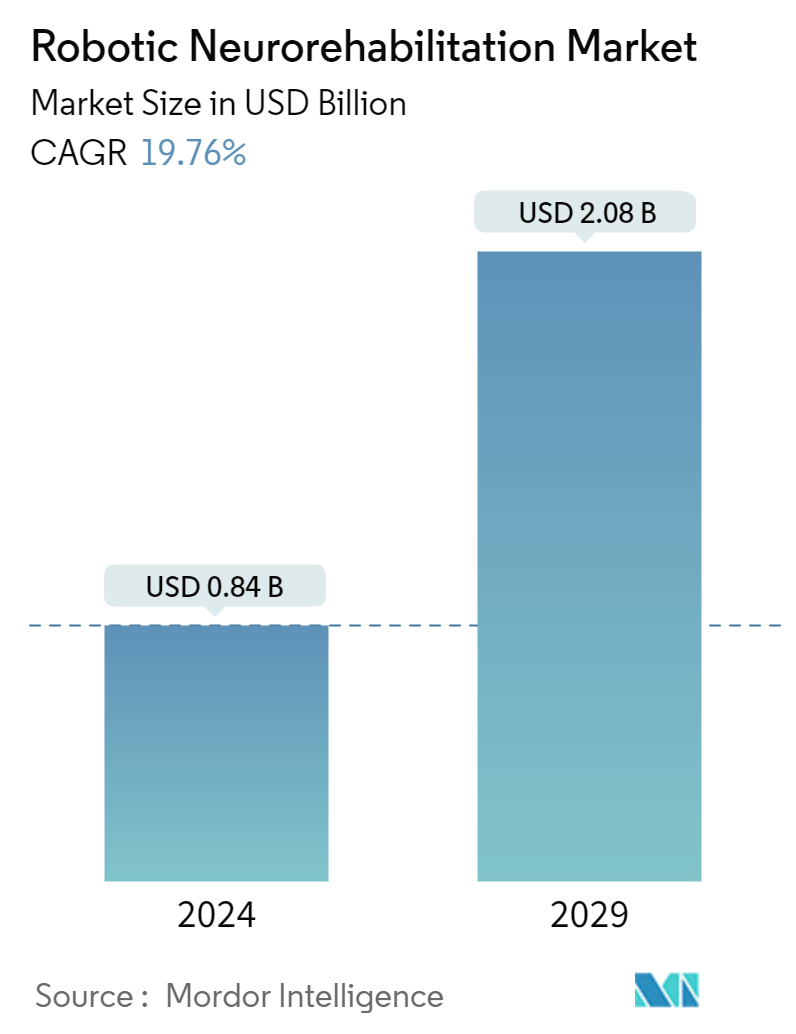
| Study Period | 2019 - 2029 |
| Market Size (2024) | USD 0.84 Billion |
| Market Size (2029) | USD 2.08 Billion |
| CAGR (2024 - 2029) | 19.76 % |
| Fastest Growing Market | Asia Pacific |
| Largest Market | North America |
Major Players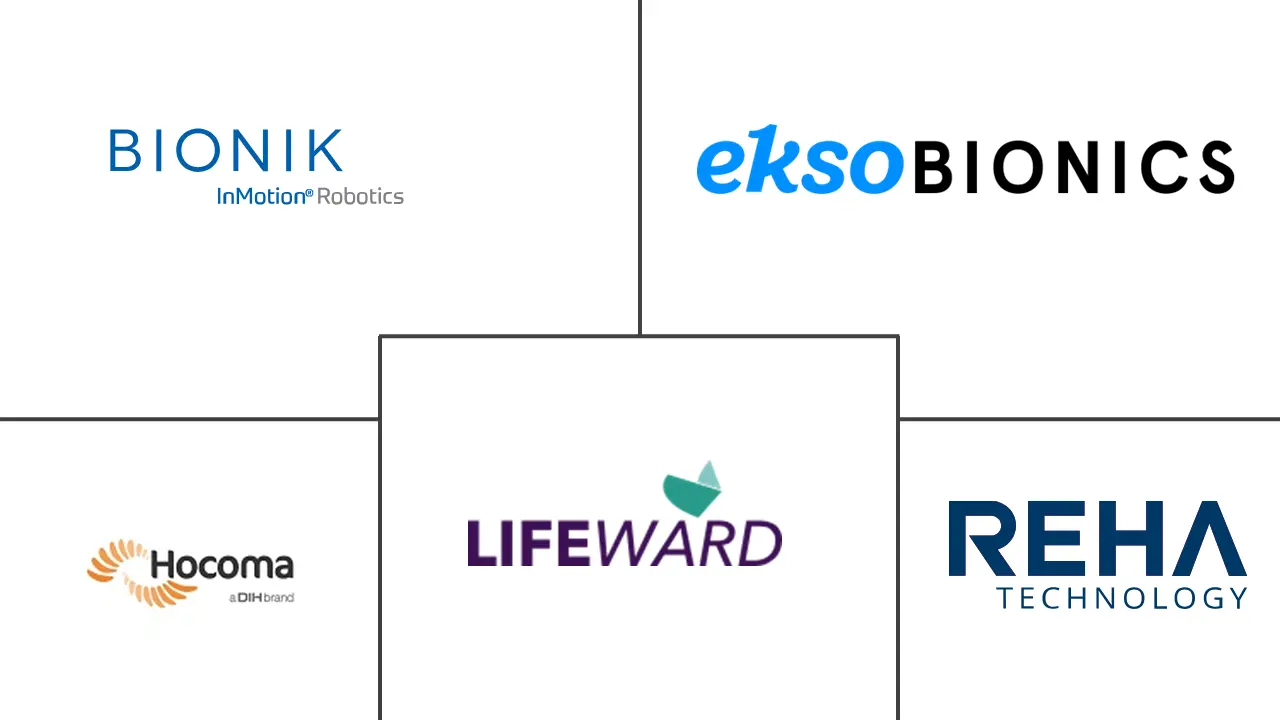
*Disclaimer: Major Players sorted in no particular order |
Robotic Neurorehabilitation Market Analysis
The Robotic Neurorehabilitation Market size is estimated at USD 0.84 billion in 2024, and is expected to reach USD 2.08 billion by 2029, growing at a CAGR of 19.76% during the forecast period (2024-2029).
Robot-mediated neurorehabilitation is an emerging field incorporating advances in robotic technology with neuroscience rehabilitation to define novel methods for treating neurological disorders. The demand for these products and services is attributed to the increasing prevalence of neurological disorders such as Parkinson's disease, cerebral palsy, and multiple sclerosis, coupled with increasing cases of stroke and brain and spinal cord injuries. For instance, according to a study published by the Lancet Neurology Journal in March 2024, over 3.4 billion people across the world are affected by a diverse group of neurological conditions, of which the highest contributors are stroke, neonatal encephalopathy or brain injury, migraine, Alzheimer's disease, and other dementias. The increasing patient population with neurological diseases causing motor or cognitive impairments, especially in the rapidly aging population, is expected to surge the demand for neurorehabilitation therapy over the forecast period.
Furthermore, several studies suggested that rehabilitation robots, which include therapeutic and assistive robots, support the neurorehabilitation of persons with neurological injuries and help bridge the care gap. These robotic neurorehabilitation devices are based on motor learning, resulting from intensive, repetitive, and task-oriented motor activities that require a patient's effort and attention. For instance, as per a study published by the Medical Review in February 2024, robot-assisted therapy combined with task-specific training has shown superior results in upper extremity motor function and improvements in quality of life among the Chinese population within post-stroke rehabilitation. Therefore, the frequent lack of complete recovery makes it desirable to develop novel neurorehabilitative treatments suited to the patients and better targeting the specific disability. Thus, robotic care in rehabilitation may play an essential role in the coming years.
Moreover, the increasing number of rehabilitation facilities and growing investment to accelerate research and development activities to incorporate robotic technology in rehabilitation therapy are surging the demand for these products and services across the globe. For instance, in September 2023, Trilife Hospital invested USD 180.4 million (INR 1,500 crore) to establish five new hospitals with the introduction of robotic services for advanced neuro-rehabilitation in India. Such initiatives are expected to increase accessibility and improve clinical outcomes in patients with neurologic disorders and are anticipated to surge the demand for robotic neurorehabilitation solutions, leading to market growth.
However, there are numerous barriers to the adoption of robot technology in rehabilitation. Such high levels of investments, its relatively costly maintenance and routine operation, and the lack of acceptance from healthcare professionals may restrain the market's growth.
Robotic Neurorehabilitation Market Trends
Devices Segment is Expected to Witness Growth Over the Forecast Period
Robotic neurorehabilitation is appealing due to its ease of deployment potential, adaptability to various motor impairments, and excellent measurement reliability. One of the significant objectives of rehabilitation for people with neurological diseases is to increase mobility. These robotic neurorehabilitation devices are available for the upper and lower extremities. The segment's growth is attributed to the increasing prevalence of stroke and market players' growing focus on introducing technologically advanced products to accelerate recovery time in the upper and lower extremities. For instance, according to the Global Stroke Fact Sheet 2022, about 101 million people worldwide were living with stroke in 2022, and this number has almost doubled over the last 20 years. This is anticipated to drive the demand for neurorehabilitation facilities over the forecast period.
Moreover, robotic therapy has emerged as a powerful tool in the realm of stroke rehabilitation, especially concerning motor control recovery in the upper limbs. For instance, as per a study conducted in Italy and published by Tyromotion in May 2024, 81 patients with subacute stroke underwent 30 sessions of upper limb robotic rehabilitation, of which 49 patients received treatment using the customized robotic protocol, while 32 patients received standard robotic therapy without customized protocol. The results from the study revealed significant improvements in both groups in terms of upper limb motor function, strength, and activities of daily living. However, the patient group that received treatment with the customized robotic protocol yielded more significant recovery in upper limb motor function and strength than the control group. Such studies highlight the clinical benefits offered when robots are incorporated with neurorehabilitation therapy, which is anticipated to increase its penetration rate among the patient population, thereby driving the demand for these devices over the forecast period.
Additionally, the increasing funding and research grants by government authorities to support the development programs for neurorehabilitation are expected to surge the adoption rate of robotic-assisted therapy across the globe. For instance, the National Natural Science Foundation of China has funded 476 research projects with a total funding of USD 2.67 million (RMB 192.38 million) to support neurorehabilitation research in China from 2010 to 2022. Such investments are anticipated to boost the research and development capabilities for robotic neurorehabilitation devices across the globe, thereby contributing to the market growth over the forecast period.
Hence, the devices segment is expected to grow in the upcoming years due to the increasing research and development activities in robotic neurorehabilitation and the increasing prevalence of neurological conditions over the forecast period.
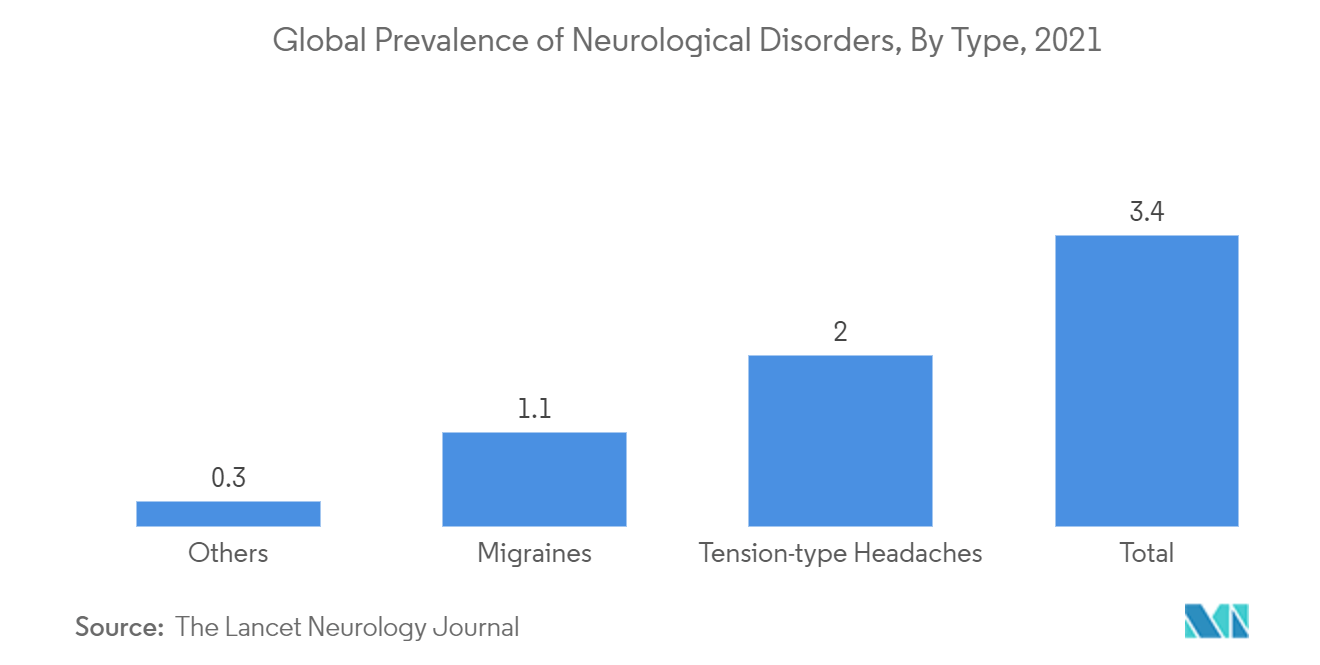
North America is Expected to Dominate the Robotic Neurorehabilitation Market
North America is expected to dominate the market due to the increasing geriatric population with neurological disorders and the rising number of rehabilitation facilities with rapid acceptance and penetration of robotic neurorehabilitation solutions across the region. In addition, a strong presence of established players offering a wide range of solutions and access to developed healthcare infrastructure is anticipated to drive market growth across the region. For instance, according to a 2024 Alzheimer's Association report, around 6.9 million Americans aged 65 and over were living with Alzheimer's dementia in 2024 of the total United States population. Furthermore, the number of Americans aged 65 and older is projected to grow from 8 million in 2022 to 82 million by 2050. The increasing geriatric population with neurological disorders is expected to surge the demand for rehabilitation facilities, contributing to market growth.
Moreover, the increasing focus of government authorities on research grants and funding for brain injuries is expected to surge the demand for neurorehabilitation facilities. For instance, as per an article published by Carleton University in August 2023, Brain Canada, in collaboration with Brain Changes Initiative (BCI), introduced the Innovation Grants for Research Impact in Traumatic Brain Injury funding opportunity to improve the trajectory of recovery for individuals after brain injury with USD 1.4 million. Such initiatives are anticipated to increase accessibility to rehabilitation care, which is expected to surge the penetration rate of these facilities over the forecast period.
Additionally, the market players operating are focused on introducing technologically advanced solutions through strategic alliances to strengthen their research and development capabilities. For instance, in December 2023, Motusium, the innovative healthcare startup based in the United States, known for its advanced rehabilitation solutions, signed a partnership agreement with Fourier Intelligence, a company providing exoskeleton and rehabilitation robotics. This collaboration aims to transform the field of neurorehabilitation, combining Motusium's expertise in robotics and AI with Fourier's technological expertise. Such strategic partnerships are expected to lead to technological innovation in the field of robotic neurorehabilitation over the forecast period.
Therefore, owing to the factors mentioned above, such as the increasing prevalence of neurological disorders among the geriatric population and technological advancements introduced by market players across the region, the growth of the studied market is anticipated in the North American region.
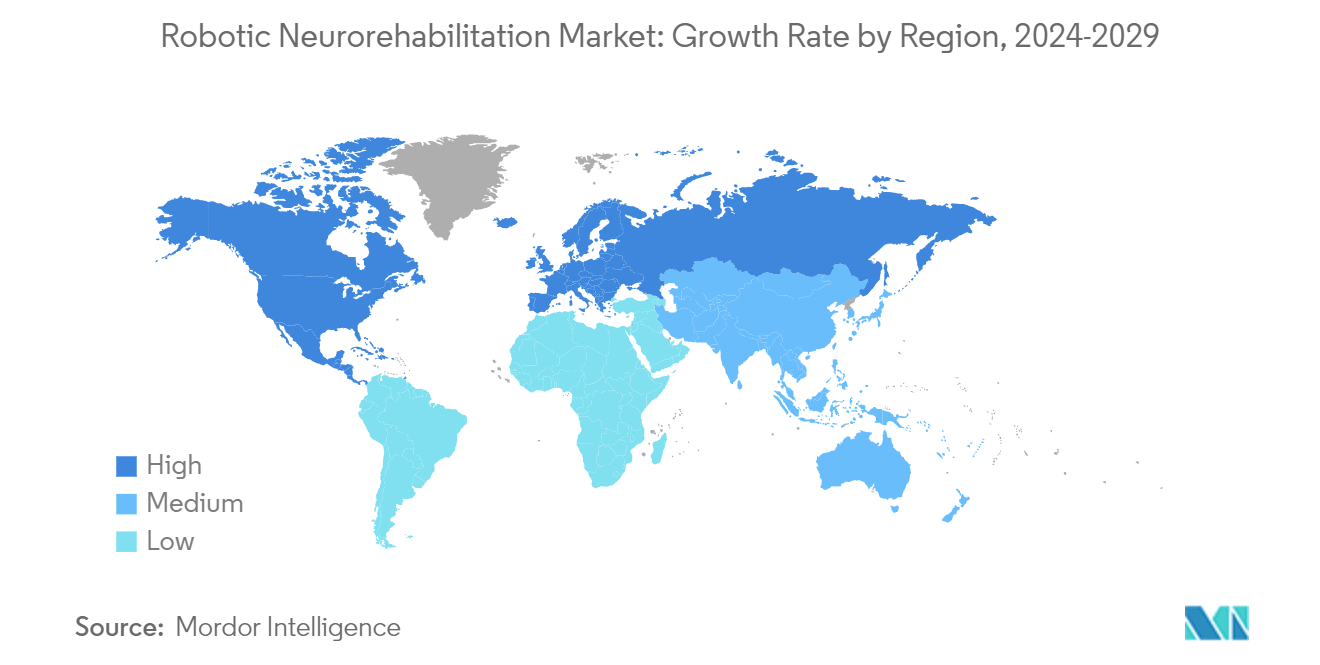
Robotic Neurorehabilitation Industry Overview
The robotic neurorehabilitation market is consolidated due to the dominance of several established players operating globally and regionally. The competitive landscape includes an analysis of a few international companies with substantial market shares, including Hocoma, BIONIK, Lifeward, Inc., and Ekso Bionics.
Robotic Neurorehabilitation Market Leaders
-
BIONIK
-
Ekso Bionics
-
Lifeward, Inc.
-
Reha Technology AG
-
DIH (Hocoma)
*Disclaimer: Major Players sorted in no particular order
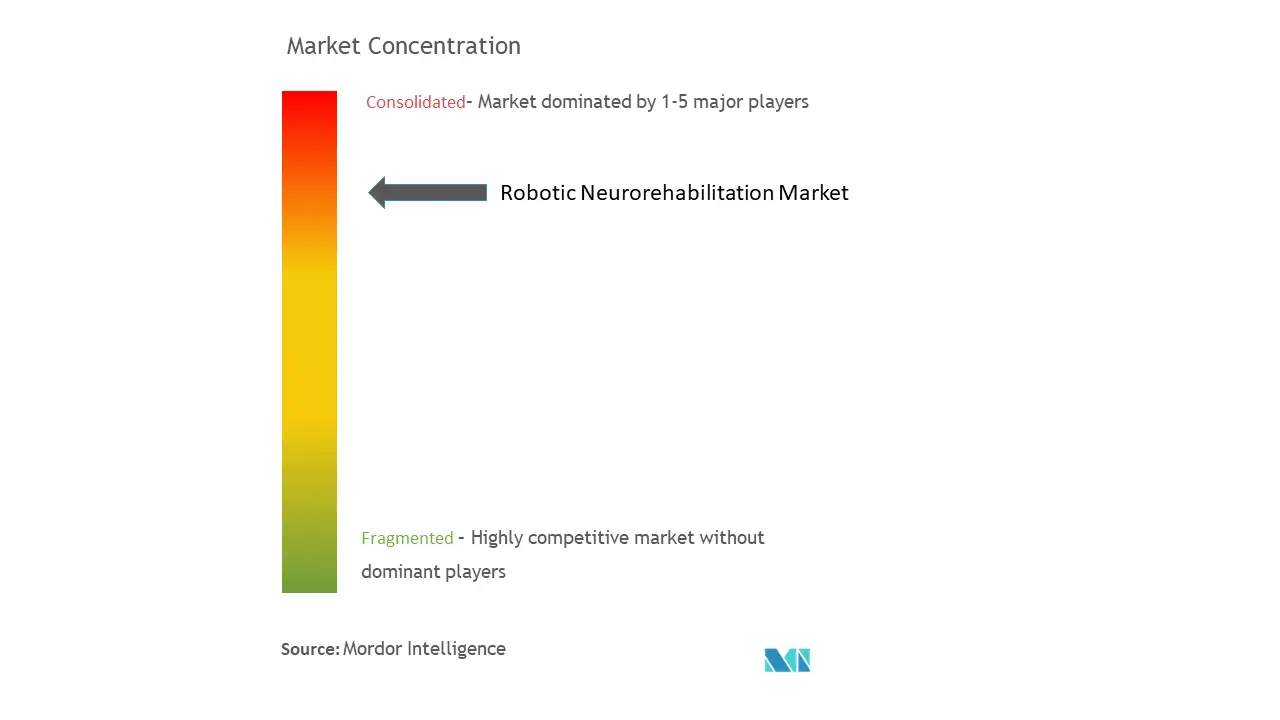
Robotic Neurorehabilitation Market News
In February 2024, DIH, a robotics and virtual reality provider in rehabilitation, completed its business combination with Aurora Technology Acquisition Corporation to grow a strategic market base and expand its position in robotic and virtual reality-enabled rehabilitation technology.
In January 2024, ReWalk Robotics Ltd rebranded as Lifeward Inc. to deliver physical and neurological rehabilitation solutions.
Robotic Neurorehabilitation Market Report - Table of Contents
1. INTRODUCTION
- 1.1 Study Assumptions and Market Definition
- 1.2 Scope of the Study
2. RESEARCH METHODOLOGY
3. EXECUTIVE SUMMARY
4. MARKET DYNAMICS
- 4.1 Market Overview
-
4.2 Market Drivers
- 4.2.1 Increasing Prevalence of Neurological Disorders
- 4.2.2 Clinical Outcomes Offered Over Conventional Methods
- 4.2.3 Technological Advancements in Robotic Devices
-
4.3 Market Restraints
- 4.3.1 High Cost Associated with Robotic Neurorehabilitation Devices
-
4.4 Porter's Five Force Analysis
- 4.4.1 Threat of New Entrants
- 4.4.2 Bargaining Power of Buyers/Consumers
- 4.4.3 Bargaining Power of Suppliers
- 4.4.4 Threat of Substitute Products
- 4.4.5 Intensity of Competitive Rivalry
5. MARKET SEGMENTATION (Market Size by Value - USD)
-
5.1 By Product Type
- 5.1.1 Devices
- 5.1.1.1 Upper Extremity
- 5.1.1.2 Lower Extremity
- 5.1.2 Consumable and Accessories
- 5.1.3 Software and Services
-
5.2 By End User
- 5.2.1 Hospitals/Clinics
- 5.2.2 Cognitive Care Centers
- 5.2.3 Other End Users
-
5.3 Geography
- 5.3.1 North America
- 5.3.1.1 United States
- 5.3.1.2 Canada
- 5.3.1.3 Mexico
- 5.3.2 Europe
- 5.3.2.1 Germany
- 5.3.2.2 United Kingdom
- 5.3.2.3 France
- 5.3.2.4 Italy
- 5.3.2.5 Spain
- 5.3.2.6 Rest of Europe
- 5.3.3 Asia-Pacific
- 5.3.3.1 China
- 5.3.3.2 Japan
- 5.3.3.3 India
- 5.3.3.4 Australia
- 5.3.3.5 South Korea
- 5.3.3.6 Rest of Asia-Pacific
- 5.3.4 Rest of the World
6. COMPETITIVE LANDSCAPE
-
6.1 Company Profiles
- 6.1.1 Humanware S.r.l.
- 6.1.2 Tyromotion GmbH
- 6.1.3 DIH (Hocoma)
- 6.1.4 BIONIK
- 6.1.5 Lifeward, Inc.
- 6.1.6 MagVenture, Inc.
- 6.1.7 Ekso Bionics
- 6.1.8 Rehab-Robotics Company Limited
- 6.1.9 eodyne
- 6.1.10 Neofect
- 6.1.11 Reha Technology AG
- 6.1.12 Barrett
- *List Not Exhaustive
7. MARKET OPPORTUNITIES AND FUTURE TRENDS
** Subject To AvailablityRobotic Neurorehabilitation Industry Segmentation
Robot-assisted rehabilitation is a type of technology that helps the functional recovery of patients with stroke, traumatic brain injury, cerebral palsy, spinal cord injuries, Parkinson’s disease, and multiple sclerosis. Robotic neurorehabilitation devices are typically based on motor learning, which requires a patient’s effort and attention to perform intensive, repetitive, and task-oriented motor activities.
The robotic neurorehabilitation market is segmented into product type, end user, and geography. The market is segmented by product type into devices, consumables, accessories, and software and services. By devices, the market is segmented into upper extremity and lower extremity. By end user, the market is segmented into hospitals/clinics, cognitive care centers, and other end users. By geography, the market is segmented into North America, Europe, Asia-Pacific, and Rest of the World. The report also offers the market size and forecasts for 13 countries across the region. For each segment, the market sizing and forecasts have been done on the basis of value (USD)
| By Product Type | Devices | Upper Extremity |
| Lower Extremity | ||
| By Product Type | Consumable and Accessories | |
| Software and Services | ||
| By End User | Hospitals/Clinics | |
| Cognitive Care Centers | ||
| Other End Users | ||
| Geography | North America | United States |
| Canada | ||
| Mexico | ||
| Geography | Europe | Germany |
| United Kingdom | ||
| France | ||
| Italy | ||
| Spain | ||
| Rest of Europe | ||
| Geography | Asia-Pacific | China |
| Japan | ||
| India | ||
| Australia | ||
| South Korea | ||
| Rest of Asia-Pacific | ||
| Geography | Rest of the World |
Robotic Neurorehabilitation Market Research FAQs
How big is the Robotic Neurorehabilitation Market?
The Robotic Neurorehabilitation Market size is expected to reach USD 0.84 billion in 2024 and grow at a CAGR of 19.76% to reach USD 2.08 billion by 2029.
What is the current Robotic Neurorehabilitation Market size?
In 2024, the Robotic Neurorehabilitation Market size is expected to reach USD 0.84 billion.
Who are the key players in Robotic Neurorehabilitation Market?
BIONIK, Ekso Bionics, Lifeward, Inc., Reha Technology AG and DIH (Hocoma) are the major companies operating in the Robotic Neurorehabilitation Market.
Which is the fastest growing region in Robotic Neurorehabilitation Market?
Asia Pacific is estimated to grow at the highest CAGR over the forecast period (2024-2029).
Which region has the biggest share in Robotic Neurorehabilitation Market?
In 2024, the North America accounts for the largest market share in Robotic Neurorehabilitation Market.
What years does this Robotic Neurorehabilitation Market cover, and what was the market size in 2023?
In 2023, the Robotic Neurorehabilitation Market size was estimated at USD 0.67 billion. The report covers the Robotic Neurorehabilitation Market historical market size for years: 2019, 2020, 2021, 2022 and 2023. The report also forecasts the Robotic Neurorehabilitation Market size for years: 2024, 2025, 2026, 2027, 2028 and 2029.
Robotic Neurorehabilitation Industry Report
Statistics for the 2024 Robotic Neurorehabilitation market share, size and revenue growth rate, created by Mordor Intelligence™ Industry Reports. Robotic Neurorehabilitation analysis includes a market forecast outlook for 2024 to 2029 and historical overview. Get a sample of this industry analysis as a free report PDF download.



